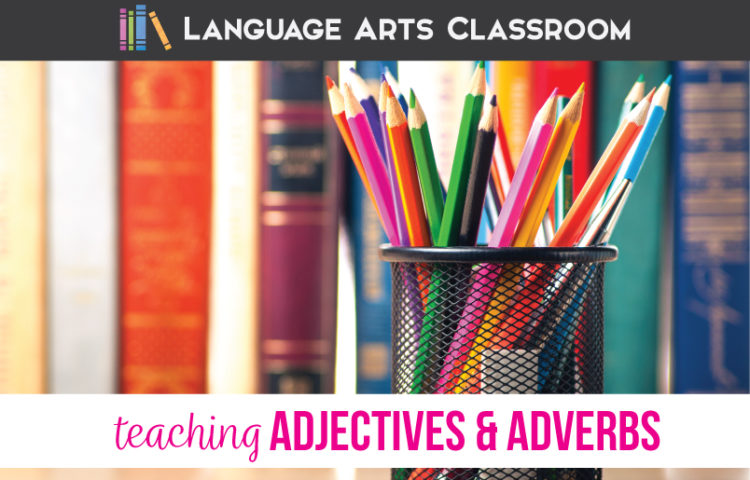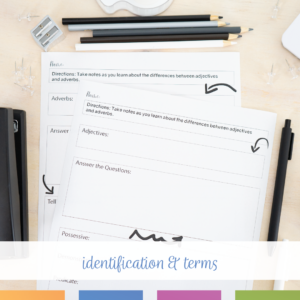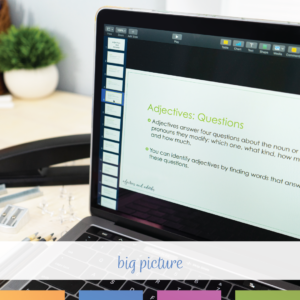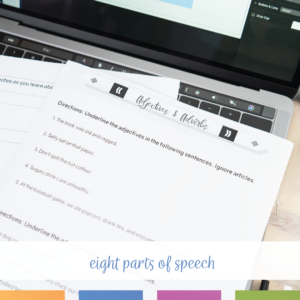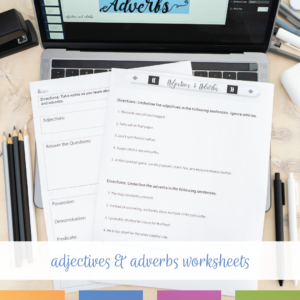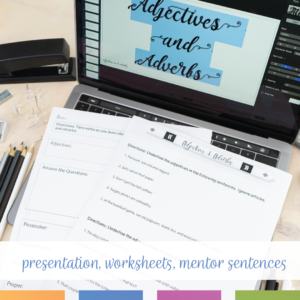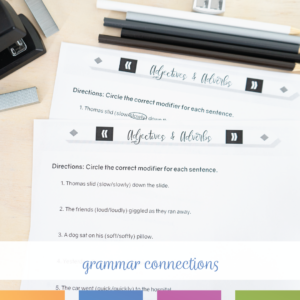Reviewing modifiers? Here are ideas for using adjectives and adverbs worksheets, task cards, and more.
Even I think reviewing basic grammar is not jazzy fun; a more engaging activity is diving into a sentence and seeing how to make it stronger, better, more persuasive. I prefer to ponder why an author used a certain modifier. Therefore, when using an identifying adjectives or adverbs worksheet, I work to apply the ideas to student writing, to amp up connections and fun.
Plus, I look for other ways to work on modifiers, especially as we advance to misplaced and dangling modifiers. Doing so helps everyone connect grammar to writing, connect language to real life.
One goal in my teaching grammar to students is so that we all have domain-specific language. When my students and I get to the point concerning writing feedback like “weak modifiers” or “misplaced modifiers” or “confused modifiers,” I want them to know the terms. Plus when students look up a word in a dictionary, I want them to have confidence in knowing the terminology—in knowing how new words work in sentences.
Finally, I want them to question the adjectives and adverbs marketers and politicians use.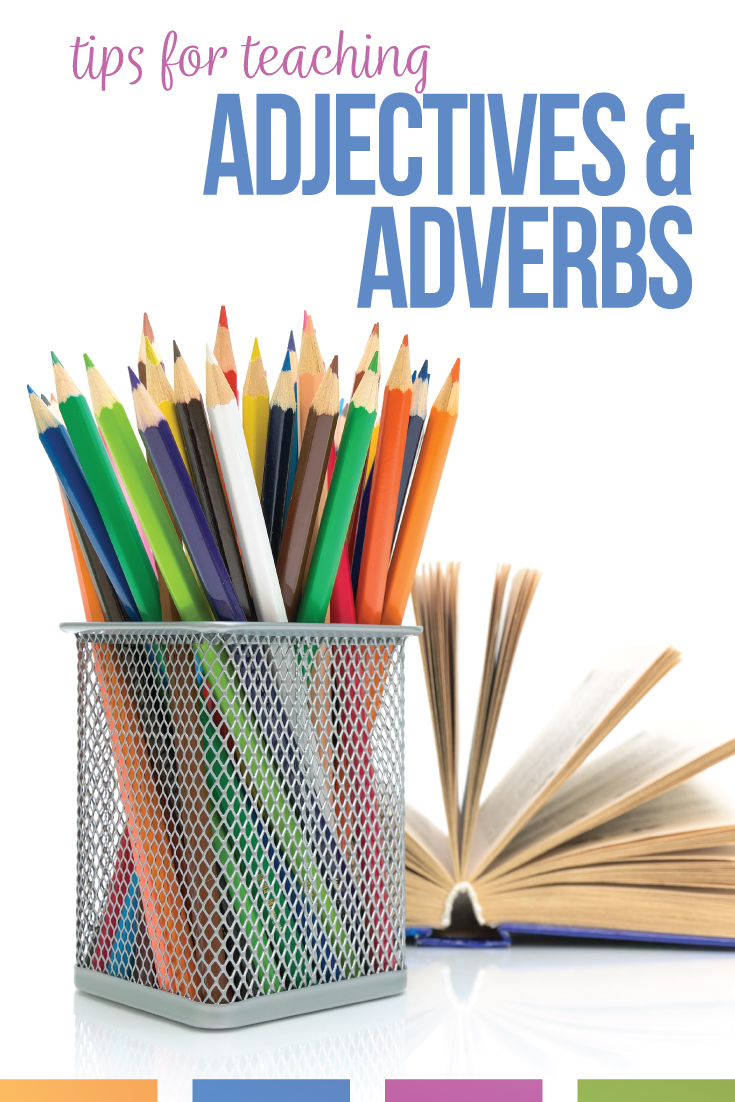
Also? I provide feedback about adjectives and adverbs with student writing. . . often! Using too many modifiers with weak verbs is a common area for improving writing. With writing feedback, young writers should understand the eight parts of speech. Sometimes a quick adjective or adverb worksheet provides a refresher for older students.
Finally, teaching the basics is part of Bloom’s Taxonomy: Students must understand the basics before they can manipulate and analyze.
How do you identify adjectives and adverbs in a sentence?
To identify adjectives and adverbs in a sentence, look for words that describe or modify nouns (adjectives) and verbs, adjectives, or other adverbs (adverbs). Adjectives answer the questions “What kind?” and “Which one?” while adverbs answer the questions “How?”, “When?”, and “Where?”.
Start with definitions!
Big ELA Picture
As a high school teacher, I understand when a 2nd grade teacher questions the depth of English grammar. No one wants to limit young writers’ love of engagement, and teachers fear that grammar can end limit writing potential. Plus, the conventions of standard English are rightfully called into question considering multiple and diverse use in America.
But! If older classes do not own that foundation of the English language, whether it be pronouns, conjunctions, suffixes, prepositions, or basic usage, those classes will struggle to understand complex pieces like misplaced and dangling modifiers, types of clauses, and long word order.
Plus, the standards for older grades asks us to look at how language changes over time and is contested. The use of modifiers comes up in our discussions, and those classes must own the domain-specific language.
Without a strong grammar foundation, fun and analytical activities won’t make sense. Using adjectives and adverbs worksheets with direct instruction is part of the formula.
Eight parts of speech
To begin, I do tell students that adjectives and adverbs are both modifiers, but I don’t stress students with the idea that they can be confused. Overall, classes might need a few reminders concerning the differences, but numerous times, I simply teach adjectives and adverbs with the eight parts of speech.
When teaching the eight parts of speech, a pre-test helps me to identify where to focus. We review where necessary, and sometimes, they understand! No need to stress the differences of adjectives and adverbs exists.
Basically, don’t invent problems classes don’t have. When students understand modifiers, we continue without the discussion surrounding confused modifiers.
Adjectives and adverbs worksheets
However, sometimes students find all modifiers confusing, especially in later lessons when studying verbals, adjective and adverb clauses, or misplaced and dangling modifiers. At this point, circle back to the differences between adjectives and adverbs.
To begin specifying, students create anchor charts. We start with definitions and questions that each modifier answers. If those work well, I might ask students to invent samples to “teach” their classmates.
With middle school students, I do provide direct instruction and yes, adjectives and adverbs worksheets. As a class, we work through guided notes that students can reference. I’ve found that the key to getting students to remember those rules in their writing it to reference the guided note sheets. (Ask students to keep those notes in their binders.)
With high school students, a few examples together as a class will probably remind students of adjectives and adverbs. I will be sure to emphasize adjectives and adverbs with our vocabulary to strengthen this review. Typically, I review coordinate adjectives with high school students as they do have prior knowledge of adjectives and adverbs. Comma placement is often difficult for older writers.
Powerpoint, worksheets, mentor sentences
Direct instruction (presentation and worksheets) and repetition (flashcards) can move classes toward understanding. Posting a presentation digitally helps my classes because everyone can reference the material.
Other times, a quick review with adjectives and adverbs worksheets helps older classes, especially when they review for standardized tests. The English portion typically has at least one question that deals with modifier issues.
If the “typical grammar activities” still leaves students confused, add mentor sentences to your mix. Analyzing language from literature provides another perspective. For instance, here are some sentences from the young adult book Find Him Where You Left Him Dead by Kristen Simmons:
The boy stared at the water, frozen. Statue still. The steam from the pool rose around his sharply cut shins and calves. His chest was so pale it took on a reflection of the water, glowing a light blue.
Whatever mentor sentence you choose, discuss it! Above, classes will probably recognize “sharply” and “so” as adverbs. Reiterate why they are adverbs—they explain “to what degree.” “Pale” and “light” are adjectives. Emphasize that “pale” jumps back to “chest.” “Blue” can be an adjective, but in the above sentence, “a” is signaling that it is used as a noun (a color can be a “thing”).
Discuss modifiers with students with a new approach; I normally use mentor sentences. Then, circle back to the other lessons.
(Note: The book reminds me of “I Know What You Did Last Summer.”)
Connecting grammar
After focusing on modifiers, I give students a break. Typically, if a class is stuck, looking at other parts of language supports their understanding of adjectives and adverbs.
So, I return to the eight parts of speech or verbals… whatever lesson inspired me to focus specifically on review of modifiers. Next, I tie them to verbals or the other parts of speech, perhaps with a fun activity like eight parts of speech coloring sheets. After studying them separately, I want students to see that the modifiers fit into other grammatical concepts.
Another time I circle back to modifiers is with misplaced and dangling modifiers. Those errors crop up in student writing when students expand their sentences. Longer and complex sentence construction can cause errors with modifiers. We might work on modifiers with writing errors.
As always, I review as necessary and keep the anchor charts visible. We reference those as necessary, especially with a fast adjective or adverb worksheet. Some classes maybe have not practiced certain parts of speech since 4th grade! Don’t feel back introducing a spiral review.
This advice varies, as I have taught in schools where students do not study grammar until they reach my class. Every particular class has various needs, and you as their teacher knows best what your students need. Adjectives and adverbs worksheets will be part of the answer, but using various other activities as well as highlighting modifiers with vocabulary and during reading will improve your lessons as well.
Note: This post contains an affiliate link. Please read my disclosures.

